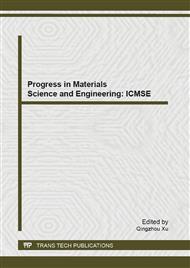[1]
R. Fürstner, W. Barthlott, C. Neinhuis, and P. Walzel, Wetting and self-cleaning properties of artificial superhydrophobic surfaces, Langmuir 21 (2005) 956-961.
DOI: 10.1021/la0401011
Google Scholar
[2]
M. Washizu, Electrostatic actuation of liquid droplets for micro-reactor applications, Industry Applications, IEEE Transactions on 34 (1998) 732-737.
DOI: 10.1109/28.703965
Google Scholar
[3]
BHJ Hofstee, Protein binding by agarose carrying hydrophobic groups in conjunction with charges, Biochem Bioph Res Co 50 (1973) 751-757.
DOI: 10.1016/0006-291x(73)91308-9
Google Scholar
[4]
M. M. Diogo, J. A. Queiroz, G. A. Monteiro, SAM Martins, GNM Ferreira, and DMF Prazeres, Purification of a cystic fibrosis plasmid vector for gene therapy using hydrophobic interaction chromatography, Biotechnol Bioeng 68 (2000) 576-583.
DOI: 10.1002/(sici)1097-0290(20000605)68:5<576::aid-bit13>3.0.co;2-5
Google Scholar
[5]
Khurram M. Sunasara, Fang Xia, Robert S. Gronke, and Steven M. Cramer, Application of hydrophobic interaction displacement chromatography for an industrial protein purification, Biotechnol Bioeng 82 (2003) 330-339.
DOI: 10.1002/bit.10582
Google Scholar
[6]
N. T. Southall, K. A. Dill and ADJ Haymet, A view of the hydrophobic effect, The Journal of Physical Chemistry B 106 (2002) 521-533.
DOI: 10.1021/jp015514e
Google Scholar
[7]
T. Onda, S. Shibuichi, N. Satoh, and K. Tsujii, Super-water-repellent fractal surfaces, Langmuir 12 (1996) 2125-2127.
DOI: 10.1021/la950418o
Google Scholar
[8]
W. Chen, A. Y. Fadeev, M. C. Hsieh, D. Öner, J. Youngblood, and T. J. McCarthy, Ultrahydrophobic and ultralyophobic surfaces: some comments and examples, Langmuir 15 (1999) 3395-3399.
DOI: 10.1021/la990074s
Google Scholar
[9]
M. Ma, Y. Mao, M. Gupta, K. K. Gleason, and G. C. Rutledge, Superhydrophobic fabrics produced by electrospinning and chemical vapor deposition, Macromolecules 38 (2005) 9742-9748.
DOI: 10.1021/ma0511189
Google Scholar
[10]
H. Y. Erbil, A. L. Demirel, Y. Avcı, and O. Mert, Transformation of a simple plastic into a superhydrophobic surface, Science 299 (2003) 1377-1380.
DOI: 10.1126/science.1078365
Google Scholar
[11]
J. Bico, C. Marzolin and D. Quéré, Pearl drops, EPL (Europhysics Letters) 47 (1999) 220-226.
DOI: 10.1209/epl/i1999-00548-y
Google Scholar
[12]
A. Pozzato, S. D. Zilio, G. Fois, D. Vendramin, G. Mistura, M. Belotti, Y. Chen, and M. Natali, Superhydrophobic surfaces fabricated by nanoimprint lithography, Microelectron Eng 83 (2006) 884-888.
DOI: 10.1016/j.mee.2006.01.012
Google Scholar
[13]
D. Öner and T. J. McCarthy, Ultrahydrophobic surfaces. Effects of topography length scales on wettability, Langmuir 16 (2000) 7777-7782.
DOI: 10.1021/la000598o
Google Scholar
[14]
L. Feng, S. Li, Y. Li, H. Li, L. Zhang, J. Zhai, Y. Song, B. Liu, L. Jiang, and D. Zhu, Super‐Hydrophobic Surfaces: From Natural to Artificial, Adv Mater 14 (2002) 1857-1860.
DOI: 10.1002/adma.200290020
Google Scholar
[15]
E. Hosono, S. Fujihara, I. Honma, M. Ichihara, and H. Zhou, Fabrication of Nano/Micro Hierarchical FeO∕ Ni Micrometer-Wire Structure and Characteristics for High Rate Li Rechargeable Battery, J Electrochem Soc 153 (2006) A1273-A1278.
DOI: 10.1149/1.2195887
Google Scholar
[16]
D. Xia, Z. Ku, S. C. Lee, and SRJ Brueck, Nanostructures and functional materials fabricated by interferometric lithography, Adv Mater 23 (2011) 147-179.
DOI: 10.1002/adma.201001856
Google Scholar
[17]
Y. L. Yang, C. C. Hsu, T. L. Chang, L. S. Kuo, and P. H. Chen, Study on wetting properties of periodical nanopatterns by a combinative technique of photolithography and laser interference lithography, Appl Surf Sci 256 (2010) 3683-3687.
DOI: 10.1016/j.apsusc.2010.01.006
Google Scholar
[18]
D. Xia and SRJ Brueck, Strongly anisotropic wetting on one-dimensional nanopatterned surfaces, Nano Lett 8 (2008) 2819-2824.
DOI: 10.1021/nl801394w
Google Scholar
[19]
C. H. Choi and C. J. Kim, Fabrication of a dense array of tall nanostructures over a large sample area with sidewall profile and tip sharpness control, Nanotechnology 17 (2006) 5326-5333.
DOI: 10.1088/0957-4484/17/21/007
Google Scholar
[20]
Gottlieb S. Oehrlein, R. M. Tromp, J. C. Tsang, Y. H. Lee, and E. J. Petrillo, Near‐Surface Damage and Contamination after CF 4/H 2 Reactive Ion Etching of Si, J Electrochem Soc 132 (1985) 1441-1447.
DOI: 10.1149/1.2114140
Google Scholar
[21]
Hyung-Ho Park, Kwang-Ho Kwon, Sang-Hwan Lee, Byung-HwaKoak, SahnNahm, Hee-Tae Lee, Kyoung-Ik Cho, Oh-Joon Kwon, and Y. I. Kang, A study on modified silicon surface after CHF3/C2F6 reactive ion etching, Etri J 16 (1994) 45.
DOI: 10.4218/etrij.94.0194.0014
Google Scholar
[22]
J. Yoo, Kyunghae Kim, M. Thamilselvan, N. Lakshminarayn, Young Kuk Kim, Jaehyeong Lee, Kwon Jong Yoo, and Junsin Yi, RIE texturing optimization for thin c-Si solar cells in SF6/O2 plasma, Journal of Physics D: Applied Physics 41 (2008) 125205.
DOI: 10.1088/0022-3727/41/12/125205
Google Scholar
[23]
E. S. Gadelmawla, M. M. Koura, TMA Maksoud, I. M. Elewa, and H. H. Soliman, Roughness parameters, J Mater Process Tech 123 (2002) 133-145.
DOI: 10.1016/s0924-0136(02)00060-2
Google Scholar
[24]
Y. C. Jung and B. Bhushan, Wetting transition of water droplets on superhydrophobic patterned surfaces, Scripta Mater 57 (2007) 1057-1060.
DOI: 10.1016/j.scriptamat.2007.09.004
Google Scholar
[25]
ABD Cassie and S. Baxter, Wettability of porous surfaces, Trans. Faraday Soc. 40 (1944) 546-551.
DOI: 10.1039/tf9444000546
Google Scholar
[26]
Robert N. Wenzel, Resistance of solid surfaces to wetting by water, Ind. Eng. Chem 28 (1936) 988-994.
DOI: 10.1021/ie50320a024
Google Scholar
[27]
X. M. Li, D. Reinhoudt and M. Crego-Calama, What do we need for a superhydrophobic surface? A review on the recent progress in the preparation of superhydrophobic surfaces, Chem. Soc. Rev. 36 (2007) 1350-1368.
DOI: 10.1039/b602486f
Google Scholar


